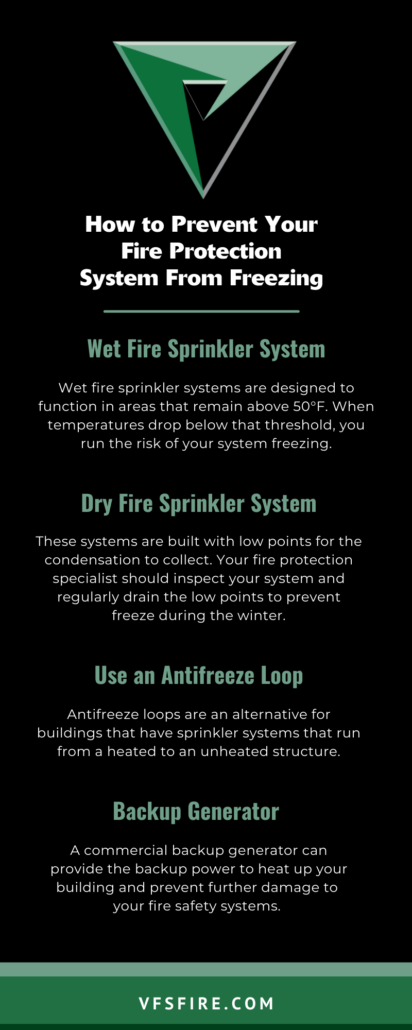Last year, hell froze over, AKA Texas. The Lone Star State, not commonly known to endure extreme icy weather, experienced a winter freeze that left thousands without power for a few days. Without heat, water running through pipes froze, causing the pipes to burst.
Some of those pipes were connected to fire sprinkler systems. Your building’s sprinkler systems need to be protected against the damage cold weather can do.
When your sprinkler system freezes, it is unable to function properly when you need it most. Your frozen sprinkler systems will likely lead to greater maintenance issues down the line, which could lead to having to replace your entire sprinkler system.
Keep reading to learn how to properly prepare your fire protection system this winter and avoid having to say, “Houston, we have a problem.”
How to Maintain Your Fire Protection System
Maintaining your fire protection systems looks differently whether the system is a wet or dry fire sprinkler system. Annual inspections and regular maintenance can help protect your building against the damage of a winter storm.
Wet Fire Sprinkler System
Wet fire sprinkler systems are designed to function in areas that remain above 50°F. When temperatures drop below that threshold, you run the risk of your system freezing.
Most commonly, wet fire sprinkler systems freeze when the heat to a building is accidentally turned off or loses power. In most wet fire sprinkler systems, this isn’t an issue. However, as we saw in Texas last year, anything can happen!
In commercial buildings, rooms that are less heat-regualted, like maintenance closets and equipment rooms, it’s important to keep warm air circulating, open vents, and keep doors open as often as possible.
If you have areas in your building that don’t receive any heat, it is important to insulate the sprinkler system pipes. The most common areas where wet systems can freeze and burst are:
- Skylights
- Under floors
- Entryways
- Stairwells
Dry Fire Sprinkler System
Yes, even a dry fire sprinkler system needs to be protected and maintained against the cold. Although it’s a dry system, it still accumulates condensation over time that can cause pipes to burst if left unkempt during a winter freeze. Pipes in areas that aren’t heat-regulated are especially prone to damage.
Typically, these systems are built with low points for the condensation to collect. Your fire protection specialist should inspect your system and regularly drain the low points to prevent freeze during the winter.
Use an Antifreeze Loop
Antifreeze loops are an alternative for buildings that have sprinkler systems that run from a heated to an unheated structure. For example, a sprinkler system from your office building to the attached parking garage.
The antifreeze helps lower the freezing point of water so that the water remains liquid and therefore reduces the risk of a pipe bursting. Regular maintenance during the winter months is important to monitor antifreeze levels, which can save you from a damaged sprinkler system.
Backup Generator
Now that you’ve prepared your wet and dry sprinkler systems for the winter months, it’s time to consider what might happen if a power outages occurs, or if the weather causes damage to your building. What happens if your electrical system goes out for more than 24 hours?
We recommend investing in a backup generator. A commercial backup generator can provide the backup power to heat up your building and prevent further damage to your fire safety systems.
Protect Your System
Actively inspecting and maintaining your wet and dry sprinkler systems helps you prepare for whatever emergency comes your way. Learn more about the different types of sprinkler systems (like Deluge vs pre action systems) in our article here.





